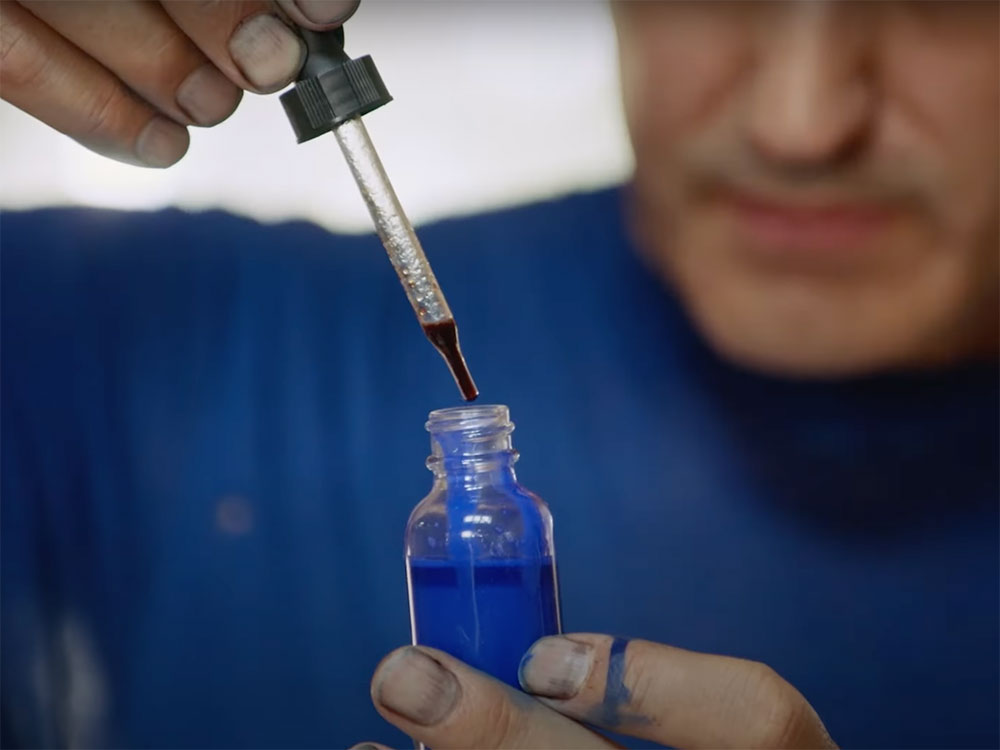Marigold yellow, rust red, fuchsia pink, chalk white, Mars black, Prussian blue, red ochre, deepest indigo.
The poetry at the heart of Brian D. Johnson’s film The Colour of Ink is just that: colour. If you feel like licking the screen in the middle of the film, that’s understandable. This is a luscious production in every possible way.
The film’s guide into the language, history and meaning of colour is Toronto ink-maker Jason Logan. Logan fell into ink almost by accident. Raised by hippie parents, he started his career as an illustrator, but a random encounter took him on a winding path into the wild, woolly world of handmade ink. As he explains in the film, “I never really set out to be an ink-maker. It all happened when I picked up a black walnut.”
Turns out that almost anything can be made into ink — Carrara marble, New York rust, carbonized peach pits, old rail spikes, acorn caps, berries, beetles. Since humans started making images, they have also made ink. The very first art made by human hands was made by people placing their palms on cave walls and blowing ink around them to create stencilled outlines. The stuff is ancient.
After the birth of his first child, Logan set out to find ways to make non-toxic varieties of ink. In addition to foraging for colour, he started his own company and began to send his creations out to artists that he admired, like famed Japanese calligrapher Koji Kakinuma.
Kakinuma’s art practice best exemplifies this bespoke approach to making ink. The art of Buddhist calligraphy from Japan is mesmerizing. Graceful and mutable, it creates penumbras, coronas and precise lines all with equal ease. In a scene where Logan makes an ink specifically for a large-scale project, Kakinuma first deems it too red. But as he continues to explore it, sedimentary layers of colour are slowly revealed, and the piece takes an entirely different resonance. As the artist works, his excitement at the possibilities begins to grow. “From one colour, we get so many variations," he laughs. “It’s incredible! Fucking incredible shit.”
In addition to Kakinuma, Logan’s inks are used by a number of extraordinary artists including Haida carver Corey Bulpitt, painter Grace Lynne Haynes and artist Yuri Shimojo. When Logan gifts Margaret Atwood a deep crimson ink that recalls the colour of the women’s clothing in her dystopian novel The Handmaid’s Tale, the author immediately begins doodling odd little stick figures.
Logan also tracks down the legendary cartoonist Robert Crumb. Logan finds him living in the south of France, and the two exchange ink and artwork. The pattern repeats itself with New Yorker cartoonist Liana Finck. Finck notes in the film that when she started at the magazine, it was largely older white men who made up the cartooning coterie. But she came to embrace her own style and the particularity of her ink linework. This allowed for humour to flow with freedom and wonderful silliness.
As passionate about his work as he is knowledgeable, Logan explains that he is both working with and for nature. Elemental stuff like fire, earth and water are the catalysts for ink. In addition to these basic materials, other things like gum Arabic (sap from the acacia tree), salt and lye are also necessary. But fire, and the carbon it creates, is often where ink first starts. Logan’s “precious lamp black” is created by mixing candle soot with gum Arabic to fashion a deep silky black that lasts forever. A similar ink was used by the ancient Egyptians to write on papyrus scrolls, creating some of the very first writings of human civilization.
There is an aliveness to ink that is quite unlike any other medium. In the bottle it is one colour and on paper it is something else entirely. Much of the footage of Logan creating his own work, inks dripping and flowing together so that they mix and transform, dendrites of colour seemingly moving with their own logic, is beyond ravishing. Goldenrod, neon pink or deepest red invoke an almost primal reaction that bypasses the intellect and pierces the heart. More than a few times, while watching the film, the sheer beauty of colour almost overwhelmed me. The alchemy of ink creation forms the meat of the film, but there are also rich repositories of natural history all bound up with the creation and uses of ink.
Ink as medicine
Much of human history was written in the ink that results from tiny wasps that lay their eggs on oak trees. In reaction, the tree grows galls (abnormal growths) that are rich in tannins. Ink made from these tannins bites into paper and endures over the centuries. Leonardo da Vinci’s work, the writings of Shakespeare and the U.S. Declaration of Independence were all created with this type of this ink.
But the oldest form of ink wasn’t preserved on paper but rather on human skin. When Ötzi the Iceman was pulled out of a glacier some 5,300 years after he was killed, his mummified body was found to have 61 tattoos, most aligned with acupuncture points. It was an indication that from human’s earliest days, that ink was mixed with medicine.
To Californian tattoo artist Roxx, ink and healing isn’t a surprising combination. Roxx works entirely in black, but as they explain in the film, the blackest of blacks takes some finagling. Most inks are created from burning bone and other animal materials, but Logan discovers ways of making ink that suits the unique needs of tattoo artists, whether they require vegan inks or those as black as the deepest night.
A reminder of the world’s physicality
The film moves at a leisurely pace that feels suitably contemplative, given its subject’s quiet demeanour. A certain portion of the narrative is dedicated to Logan’s own story, including the early death of his mother, who was the subject of her own documentary biography. He recounts that it was his mom that planted the seeds for his later passion. As a little kid, Logan and his mother picked wild grapes that grew alongside the railway tracks near their home. Deep purple remains one of his favourite colours.
But it isn’t all yellow sunshine and bright pink roses. The sometimes wildly destructive processes by which certain colours were sourced has taken an outsized toll on the natural world. The royal purple used to dye the hem of a Roman toga required more than 10,000 sea snails. In the process of obtaining this colour, the Romans almost wiped out the entire species. Although cinnabar was used to create a deep crimson, it was highly toxic and filled with mercury. The ancient Aztecs developed a way to make fiery red using cochineal insects that fed on cactus.
Although nature is filled with vivid colour, some of the ubiquitous hues like green are hard to find. Turns out that green is hidden away in some unlikely places. Buckthorn berries mixed with lye create a bold yellowy green. It is the curious alchemical reactions, with water, salt, lye, that give rise to some of the most unexpected colours.
Some of the discoveries of how to derive colour from raw materials came about by accident. The creation of Prussian blue, for example, originated in 1706 when animal blood contaminated a batch of cochineal red. This incident turned the red ink a bright, practically fluorescent blue.
As much as the film is about the materiality of ink and paper as well as the human element in hand-making cartoons, calligraphy or tattoos, it’s also a reminder of the physicality of the world. This perambulatory aspect is also one the most charming elements, as Logan traverses the globe, travelling from rural Mexico to inner-city Toronto. The camera follows companionably along behind him as he picks at rusted walls, flips over rocks, rubs foliage, looking for unlikely sources of colour. In all of these different parts of the world, the raw materials of ink-making are found.
As a celebration of bespoke, handmade materials, The Colour of Ink is more than a testimonial to the fecundity of the planet, although that is certainly enough. It is also a poem to creativity itself. Endless invention and reinvention, all fuelled by the human need to capture the nature of existence, in washes of colour and specificity of line.
‘The Colour of Ink’ is playing at the VIFF Centre in Vancouver from April 7 to 10. ![]()

















Tyee Commenting Guidelines
Comments that violate guidelines risk being deleted, and violations may result in a temporary or permanent user ban. Maintain the spirit of good conversation to stay in the discussion and be patient with moderators. Comments are reviewed regularly but not in real time.
Do:
Do not: